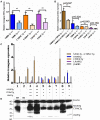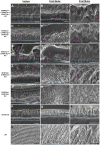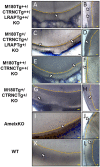Dose-Dependent Rescue of KO Amelogenin Enamel by Transgenes in Vivo
- PMID: 29201008
- PMCID: PMC5696357
- DOI: 10.3389/fphys.2017.00932
Dose-Dependent Rescue of KO Amelogenin Enamel by Transgenes in Vivo
Abstract
Mice lacking amelogenin (KO) have hypoplastic enamel. Overexpression of the most abundant amelogenin splice variant M180 and LRAP transgenes can substantially improve KO enamel, but only ~40% of the incisor thickness is recovered and the prisms are not as tightly woven as in WT enamel. This implies that the compositional complexity of the enamel matrix is required for different aspects of enamel formation, such as organizational structure and thickness. The question arises, therefore, how important the ratio of different matrix components, and in particular amelogenin splice products, is in enamel formation. Can optimal expression levels of amelogenin transgenes representing both the most abundant splice variants and cleavage product at protein levels similar to that of WT improve the enamel phenotype of KO mice? Addressing this question, our objective was here to understand dosage effects of amelogenin transgenes (Tg) representing the major splice variants M180 and LRAP and cleavage product CTRNC on enamel properties. Amelogenin KO mice were mated with M180Tg, CTRNCTg and LRAPTg mice to generate M180Tg and CTRNCTg double transgene and M180Tg, CTRNCTg, LRAPTg triple transgene mice with transgene hemizygosity (on one allelle) or homozygosity (on both alleles). Transgene homo- vs. hemizygosity was determined by qPCR and relative transgene expression confirmed by Western blot. Enamel volume and mineral density were analyzed by microCT, thickness and structure by SEM, and mechanical properties by Vickers microhardness testing. There were no differences in incisor enamel thickness between amelogenin KO mice with three or two different transgenes, but mice homozygous for a given transgene had significantly thinner enamel than mice hemizygous for the transgene (p < 0.05). The presence of the LRAPTg did not improve the phenotype of M180Tg/CTRNCTg/KO enamel. In the absence of endogenous amelogenin, the addition of amelogenin transgenes representing the most abundant splice variants and cleavage product can rescue abnormal enamel properties and structure, but only up to a maximum of ~80% that of molar and ~40% that of incisor wild-type enamel.
Keywords: amelogenin; enamel development; knockout; mineralization; transgenic.
Figures




Similar articles
-
Truncated amelogenin and LRAP transgenes improve Amelx null mouse enamel.Matrix Biol. 2016 May-Jul;52-54:198-206. doi: 10.1016/j.matbio.2015.11.005. Epub 2015 Nov 19. Matrix Biol. 2016. PMID: 26607574 Free PMC article.
-
Rescue of the murine amelogenin null phenotype with two amelogenin transgenes.Eur J Oral Sci. 2011 Dec;119 Suppl 1(Suppl 1):70-4. doi: 10.1111/j.1600-0722.2011.00882.x. Eur J Oral Sci. 2011. PMID: 22243230 Free PMC article.
-
M180 amelogenin processed by MMP20 is sufficient for decussating murine enamel.J Dent Res. 2013 Dec;92(12):1118-22. doi: 10.1177/0022034513506444. Epub 2013 Sep 26. J Dent Res. 2013. PMID: 24072097 Free PMC article.
-
The use of animal models to explore amelogenin variants in amelogenesis imperfecta.Cells Tissues Organs. 2005;181(3-4):196-201. doi: 10.1159/000091381. Cells Tissues Organs. 2005. PMID: 16612085 Review.
-
Amelogenin protein exhibits a modular design: implications for form and function.Connect Tissue Res. 2003;44 Suppl 1:47-51. Connect Tissue Res. 2003. PMID: 12952173 Review.
Cited by
-
Computational approach towards identification of pathogenic missense mutations in AMELX gene and their possible association with amelogenesis imperfecta.Mol Biol Res Commun. 2020 Jun;9(2):63-69. doi: 10.22099/mbrc.2020.35413.1456. Mol Biol Res Commun. 2020. PMID: 32802900 Free PMC article.
-
Enhancing Collagen Mineralization with Amelogenin Peptide: Towards the Restoration of Dentin.ACS Biomater Sci Eng. 2020 Apr 13;6(4):2251-2262. doi: 10.1021/acsbiomaterials.9b01774. Epub 2020 Feb 21. ACS Biomater Sci Eng. 2020. PMID: 33313393 Free PMC article.
-
Mapping the Tooth Enamel Proteome and Amelogenin Phosphorylation Onto Mineralizing Porcine Tooth Crowns.Front Physiol. 2019 Jul 30;10:925. doi: 10.3389/fphys.2019.00925. eCollection 2019. Front Physiol. 2019. PMID: 31417410 Free PMC article.
References
-
- Aldred M. J., Crawford P. J., Roberts E., Thomas N. S. (1992). Identification of a nonsense mutation in the amelogenin gene (AMELX) in a family with X-linked amelogenesis imperfecta (AIH1). Hum. Genet. 90, 413–416. - PubMed
Grants and funding
LinkOut - more resources
Full Text Sources
Other Literature Sources
Research Materials
Miscellaneous

